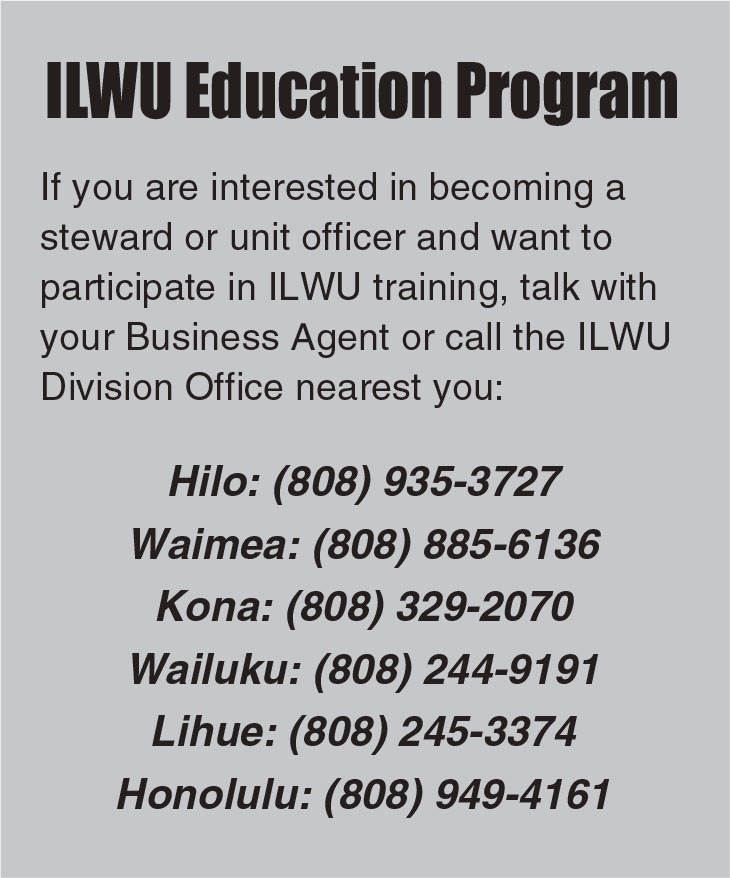With this year’s contract fight, ILWU members join the legions of dockworkers around the world who have been fighting privatization and casualization for more than a decade. Shipping and stevedoring companies have led the anti-worker drive, but governments everywhere have backed them up.
The port industry is going through global restructuring. Shipping lines and port service companies, like Maersk-Sealand and Stevedoring Services of America, are consolidating globally. They are coming to dominate ports formerly owned and run as public trusts. Privatization steps up pressure to lower costs— and take savings out of workers’ hides. From Britain to Brazil, Australia to Amsterdam, longshore workers have had to step up to defend their wages, working conditions and basic union rights.
The timeline at right sketches the history of this fight. October visits to the ILWU by members of the International Dockworkers Council and representatives from waterfront unions in Australia and New Zealand gave a glimpse of today’s battles around the world. The Dispatcher first talked with the IDC’s General Coordinator Julián García, who is also head of the Spanish dockers’ union Coordinadora, and IDC’s European Coordinator, Björn Borg, president of the Swedish dockworkers’ union Svenska Hamnarbetarförbundt. Jose Luis Llorca of Coordinadora translated for García.
Borg: Today’s situation began unrolling in 1989, when the rightwing government of British Prime Minister Margaret Thatcher abolished the Dock Labour Scheme, Borg noted. “It’s a process. They want to de-regulate, cut off our work conditions, cut off our workplaces, cut off the workers from participation in any changes.
“They tried this in France in the ’90s but the dockworkers won the fight. In Amsterdam the dockworkers lost a fight in 1997—they came to the IDC meeting in Montreal just after that.”
García: “The fight is the same all over the world. The only difference is the tactics the employers are using.” In the United States, the employers are trying to use the contract fight to bust the union. In Europe, they are going after legislation that will do the same thing.
“Italy passed laws that allow ports to work non-union. Portugal and Spain are fighting against them.”
Borg: “The European Union’s Port Directive is about the different shipping companies being allowed to run their own operations with their own people without hiring unionized dock workers. They could use ships’ crews or hire others, which would be devastating for us.
“The ILWU’s contract fight is of great concern not only in Sweden but in other European countries. We think a major struggle like this one will affect all of us, since the shipping companies are multinational, like Maersk, which by origin is a Danish company but plays a role here in the U.S. as well. We know what they’re aiming at. They want to get rid of the unions in all the docks and ports. It’s not about money. It’s about who’s got the biggest influence in the ports.
García: “The Port Directive and the ILWU fight are ‘two sides of the same coin.’ We are the last really strong organizations of workers. The employers alone can’t take us on. They need the help of the government. This is proof of the relations between the governments and the companies. We say ‘the governments are the hands of the companies.’”
While Borg and García were visiting the San Francisco Bay Area, a 17-member delegation of officers and rank-and-filers from the Maritime Union of Australia (MUA), the Confederation of Mining and Energy Unions (CFMEU) in Australia, the New Zealand Seafarers’ Union and the New Zealand Waterfront Workers Union (NZWWU) came to Southern California. The Dispatcher spoke with Barry Robson, assistant secretary of MUA’s Sydney branch; Gary Keane, assistant secretary of its timber branch; Peter Murray, vice president of CFMEU’s United Mine Workers Division and Trevor Hanson, General Secretary of the NZWWU.
Robson: “This delegation was put together to support the ILWU in its hour of need to repay the great debt we owe the ILWU for their support of us in our lockout in the Patrick’s ’98 dispute.”
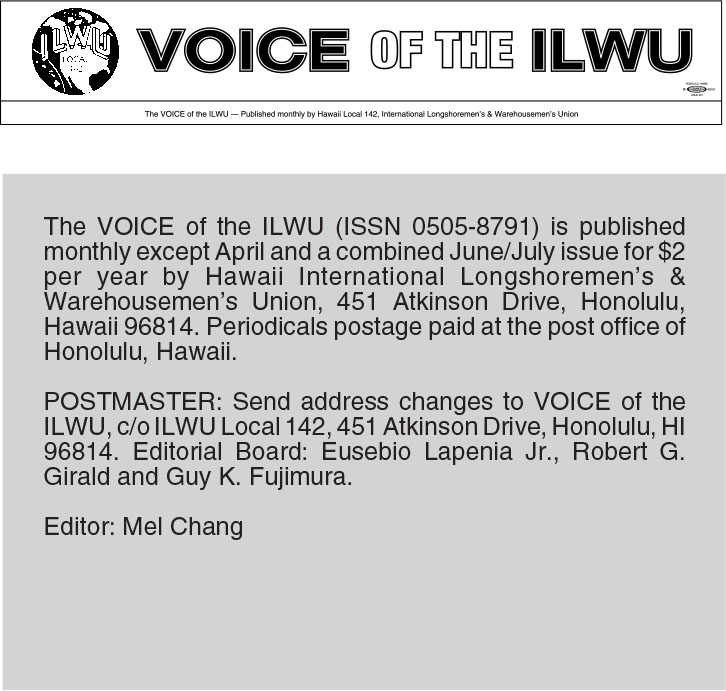
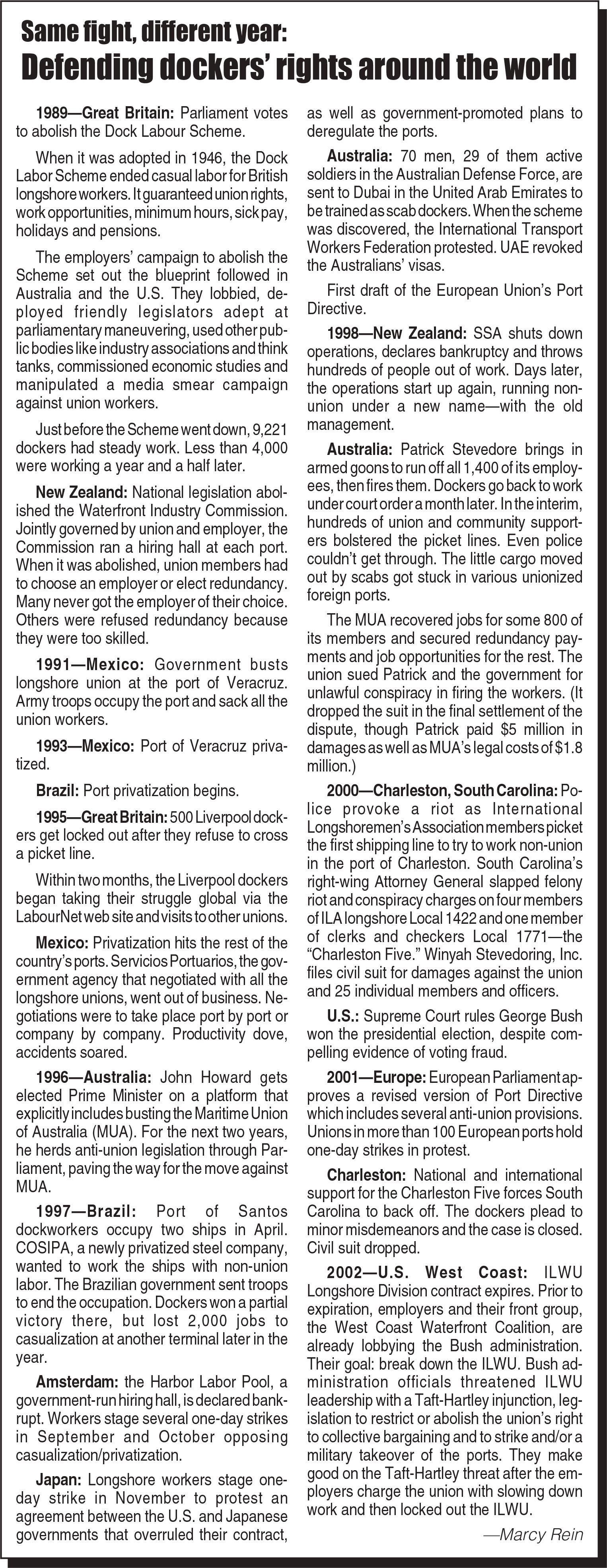
DAY 2: Building Member Power
All five workshops on the second day tackled the age-old problem of how to get more members involved in their union. Members ARE the union, but too often the only people involved and doing the work are the same small group of unit leaders. These workshops provided answers and taught participants how to use tools like mapping, surveys, and oneon-one contacts to build member involvement and union power.
Building an Internal Leadership Core
The ILWU hired Gordon Lafer and Rachel Kirtner for 18 months to run a demonstration Hotel Mobilizing Project which came to involve almost 2000 members at the Hyatt Maui, the Grand Wailea Resort, and the Royal Lahaina Hotel. The campaigns were successful in gaining a good contract at the Hyatt Maui, maintaining union recognition at the Grand Wailea, and rebuilding a strong unit at the Royal Lahaina Hotel. Gordon is with the Labor Education and Research Center of the University of Oregon. In this workshop, Gordon taught how a strong, internal leadership group was essential to the success of each of these campaigns.
Participants learned how to analyze the makeup of their membership and why it is important to recruit leaders who represent important groups within the membership. They learned how to build an internal communications network that could reach every member within 24 hours. They learned how to increase involvement by asking members to take small, comfortable steps and moving them to take bigger steps in support of the union.
“This was a great class. Gordon was very clear on instructions and discussions.”—Lani Moala.
“For me being new all these classes are very informative and helpful.”— Tom Brown.
Mobilizing Around Grievances
Rachel Kirtner worked with Gordon Lafer on the ILWU Hotel Mobilizing Project on Maui. She is now a business agent with the Service Employees International Union in Oregon. In this workshop, Rachel taught how they used grievances as a powerful organizing and educational tool in the struggle at the Royal Lahaina Hotel. Participants learned how to choose the right grievance issues that affected large groups of people and built unity. Participants learned how to involve members in the grievance process and how to handle grievance meetings with management.
"Rachel was a great instructor, fun & everybody had a great time.”— Mike Bunyard.
“She gave me real vision of how to feel and demonstrate power in a grievance. She’s awesome.”— Linda Quiqley.
“Learning what kind of information to ask for—how to handle yourself.”—Janelle Kaneoka.
Reaching the Membership
PJ Dowsing Buie is the Southern Regional Education Director with the Service Employees International Union. PJ has a tremendous wealth of knowledge and experience in the union movement, which she shared in her workshops. Among other topics, PJ covered the importance of one-on-one communications and gaining the support of every newly hired worker.
“Everybody put in their input— great class participation. She is very good, very articulate.”—Ven Garduque.
Mobilizing and Organizing Skills
Grainger Ledbetter is with the Labor Education Program at the University of Arkansas at Little Rock. Grainger’s workshop stressed how ILWU units need to have an action plan and consciously organize themselves to continually recruit and maintain the support of members. Grainger covered how to use many of the internal organizing tools such as mapping the workplace, profiling the membership, running a new hire’s orientation programs, and making one-on-one contacts.
“Doing a member profile as a way to reach the members was an excellent idea brought up in class. It was exactly what I needed to know about helping my members and officer to get started.”—Anna Ater.
Fighting an Anti-union Employer
Diane Thomas-Holladay’s workshop covered how to mobilize members and fight back in the special situations when the employer wants to break the union. This is happening more often to ILWU members as companies change management due to corporate buyouts and mergers. Participants learned about their rights under the National Labor Relations Act and how the law prohibits certain unfair labor practices by management. Participants learned how to respond to the typical tactics used by employers in an anti-union campaign.
“Mobilizing the membership, one on one, instructor fluent and very well coordinated.”—Milton Ohira.
“Most useful was going over rights covered by NLRA.”—Lance Kamada.
“She was fearless in exposing the lies that businesses engage in.”—Greg Gauthier.
DAY 3 & 4: Pressuring Employers
The ten workshops offered on Wednesday and Thursday centered on what unionism is all about— protecting and improving the wages, benefits and conditions of union members. Most of the workshops covered how to use the media, the legal system, government regulations, and corporate campaigns to put pressure on management and protect workers. Other workshops focused on how to do a better job of dealing with management in contract negotiations and grievance handling. Two workshops focused on leadership and communications skills.
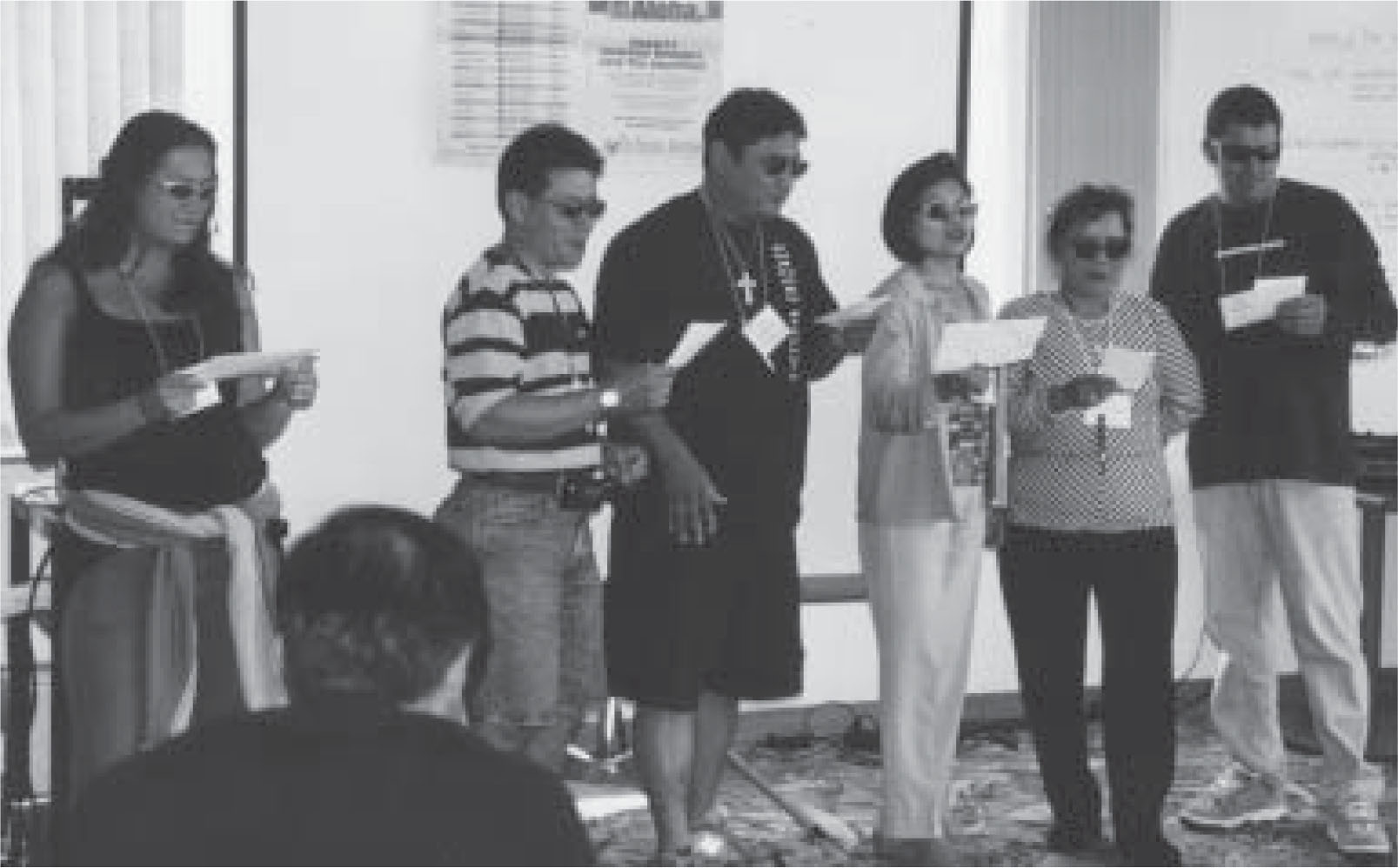
How do you get your message across? Write and sing a song. This group composed a song, sung to the tune of “Wild Thing” by the Troggs, about the struggle to protect medical benefits at their hotel. Songs can be an effective way to get your message to members and the public. A second group wrote their song to the beat of stomp, stomp, clap (we will, we will, rock you).

How do you get your message across, (part 2)? Hold a press conference. This group produced a press release and made a statement to the media about their struggle for a fair contract with a leading Honolulu newspaper. An effective media statement constantly repeats the main issue to make sure the message is aired. Union spokesperson Lance Kamada (left) makes a statement as Mike Bunyard plays the role of a television reporter.
Corporate Campaign Strategies
Tracy Chang taught two workshops on running corporate campaigns. In these workshops, participants worked in small groups to identify the important economic, political, and structural connections between their employer and other groups such as major customers, other employers, suppliers and vendors, shareholders, banks, government agencies, the public, its workers and the union, middle management, politicians, and the media. They learned how to identify which of these were potential targets and which were allies who might support the union.
Tracy then had each group work on one of five actions which they had to present at the end of the class. The five tactics were: write a leaflet; make a fact sheet; hold a press conference; stage a media event; or compose and sing a song about their struggle.
The results were amazing as each group produced some creative and brilliant campaign actions and showed what ordinary workers were capable of doing. See the story in pictures below.
ILWU Labor Institute, Part 2 Building member power
HONOLULU—This is Part 2 of a report on the 6th ILWU Labor Institute, which was held from August 25 through 31 at Tokai University in Honolulu. The weeklong institute brought together ILWU members from all Divisions and industrial groupings for intensivetraining sessions on strategic planning, moblizing their membership, corporate campaign strategies, and coalition building to increase orgaanizational strength.
Using Political, Legal, and Government Pressure
Bill Puette, the director of the Center for Labor Education and Research at the University of Hawaii West Oahu, covered how to use the law and government regulations to protect workers rights. The laws covered in this workshop included wage and hour, prevailing wage, civil rights and anti-discrimination, health and safety, national labor relations act, dislocated workers act, and family leave.
Staying out of Trouble with the Law
Diane Thomas-Holladay’s workshop focused on the rights of workers under the National Labor Relations Act. Subjects covered included the rights of union stewards, leafleting and talking union on the job, picketing, and the differences between economic and unfair labor practice strikes, and the employer’s duty to bargain and provide information.
Collective Bargaining and Grievance Handling
Gordon Lafer, Rachel Kirtner, PJ Dowsing-Buie, and Grainger Ledbetter taught workshops that went more into depth on preparing for contract negotiations with management. Their workshops covered setting up the negotiating committee, mobilizing and organizing members through a communications network and solidarity actions, and the do’s and don’ts in negotiations. PJ also taught a one-day workshop on strategic grievance handling based on membership involvement and solidarity.
Effective Communications and Leadership
Dawn Addy offered a workshop on how to more effectively tell labor’s story to the public and union members. Besides learning how to write press releases and produce a better news bulletin, participants learned how to use chants and songs to get the union message to members. Adrienne Valdez taught a workshop geared to new leaders on practical steps to improve their skills as leaders.
DAY 5: Gaining Community and Public Support
The public can be an important ally and supporter of a union’s struggle for justice, or the public can be used by management and turned againt the union. The workshops on the last day of the institute taught how to build public support by forming coalitions with community organizations and making better use of the news media to get the union’s message to the public.
Building Community Support
Dawn Addy’s workshop was all about identifying community groups and organizations who could support our struggle as workers. Participants learned how best to approach these groups to gain their support and how to use tools such as petitions and resolutions.
“Viewing the video about BASF and the lockout. We are proud to be in the ILWU. I know we will stand together even if this should happen to us!!! Build power which this week has shown me. We have the tools!”— Abeleen Lau.
“Getting to know the importance of creating coalitions in labor and community to reach agreement on how to get a fair settlement in contract disputes.”—Nick Lopez.
Developing a Media Strategy
Grainger Ledbetter taught how to more effectively use the mass media to get labor’s message out to the community—know your audience, match the media to the audience, and translate your issues to make it more understandable to the audience. The workshop also covered how unions need to monitor the press, cultivate relations with reporters, and write more Letters to the Editor.
“How to think about your audience and tailoring your message to each part of the audience.”—Tanya Fujitani.
Untrue Lies About Hawaii
For the past 10 years, Forbes Magazine has slammed Hawaii as a terrible and even hostile place to do business. Some of the reasons cited by the magazine are because of strong unions and tough laws such as workers compensation and prepaid health which were supported by unions. Bill Boyd’s workshop revealed the half truths and distortions used by Forbes and business groups to promotes their agenda and spread anti-union ideas through the media.
Lessons from the 1949 Dock Strike
Theresa Bill, with the Center for Labor Education and Research at the University of Hawaii West Oahu, used a television show about the 1949 ILWU Dock Strike to teach important lessons about the need for community support. The employers attacked the union on many fronts in an effort to break the strike—a hostile press, government intervention, legal injunctions, and public pressure. The workers countered and won the strike by having their own radio show, producing a constant flow of leaflets and newspapers ads, and reaching out to gain community support.
“Film was emotional at times and makes me proud to be ILWU. Yeah ILWU!” —Clem Sweeney

How do you get your message across (part 3)? Write a leaflet. John Valera, Mac Wright, and Allen Kaina work on a leaflet directed at the stockholders of a hotel. They learned that effective leaflets target a specific audience, have specific audience, have gives a short explanation of the problem, explains why the target audience should be concerned, and explains what you want them to do about the problem.
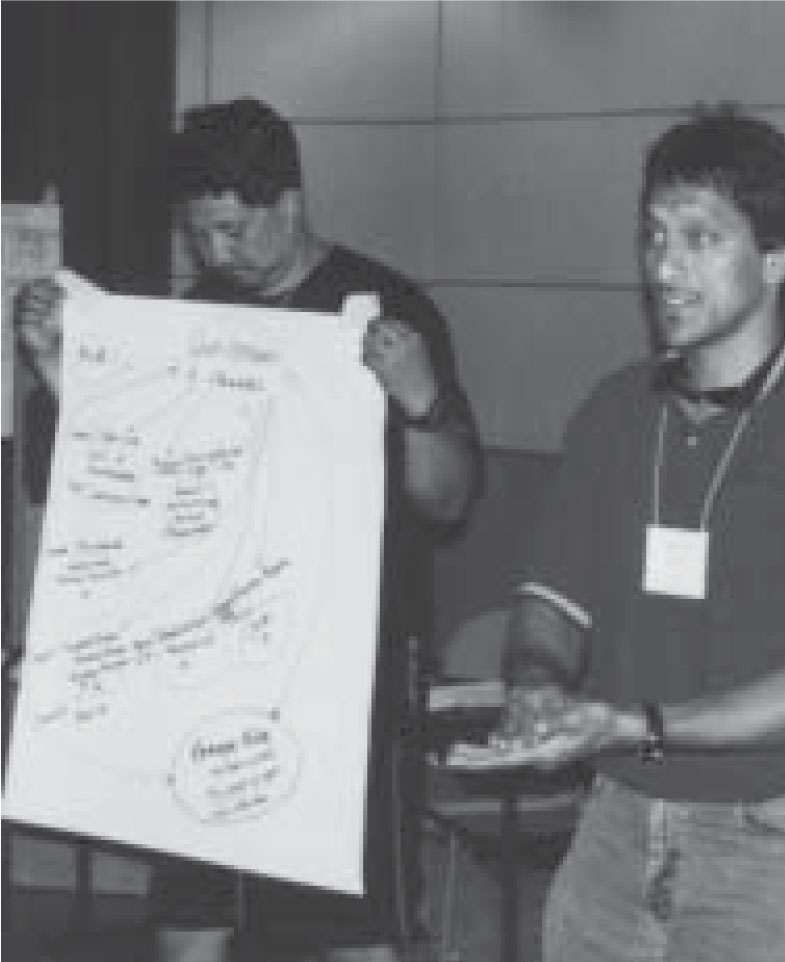
Teamwork works. Reynold Ayau (r) from Pepsi Cola with Leonard Nakoa Jr. (l) explains how there is a union activist in each department of his unit. Some are leaders because they are respected by their co-workers; some know and can get the word out to everyone in their department; others speak the language of a particular ethnic group. Each member of this leadership team brings different strengths and abilities to the group.
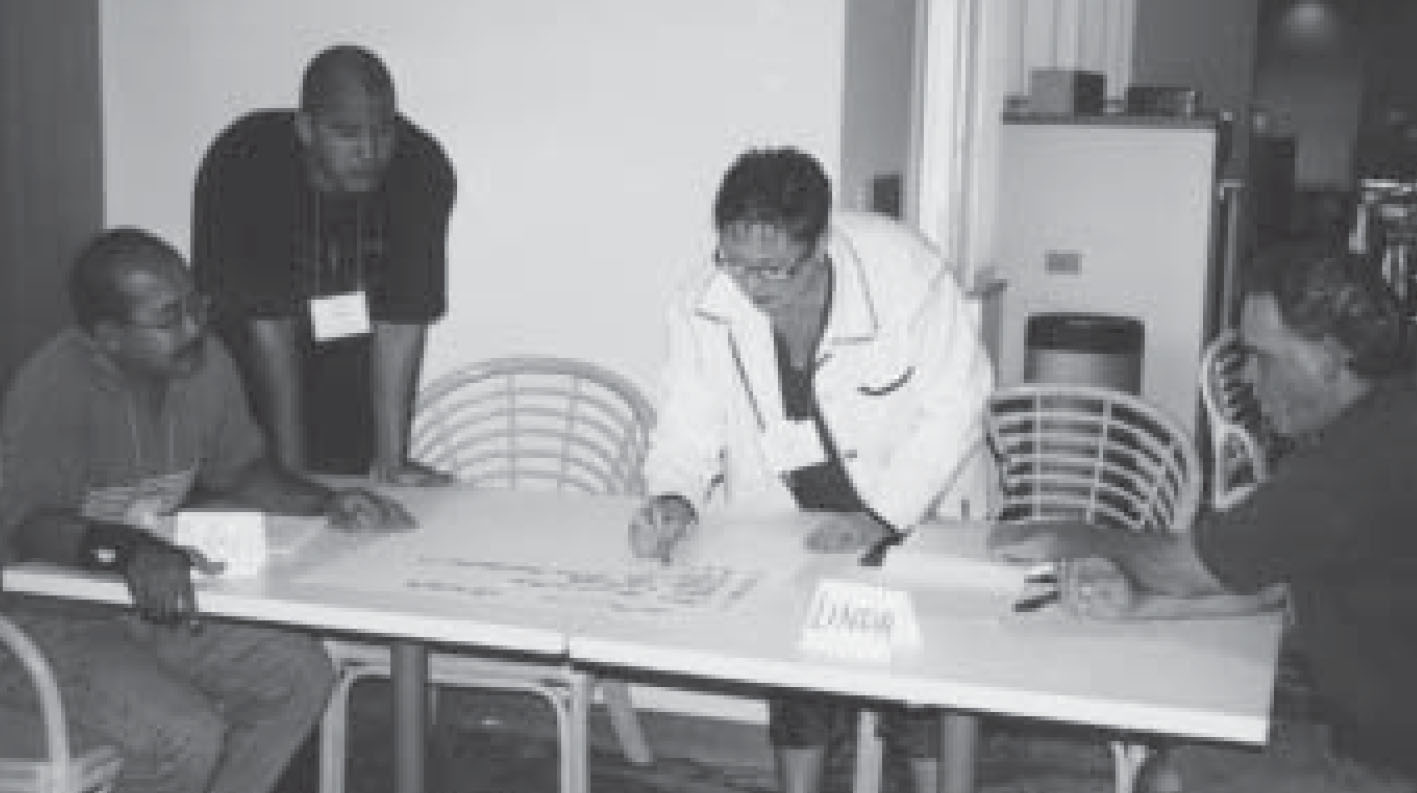
What makes a good leader? Leadership is a skill that can be learned and developed. Ven Garduque, Paul Santos, Linda Quigley, and Tom Brown make a list of the qualities of a strong leader.
